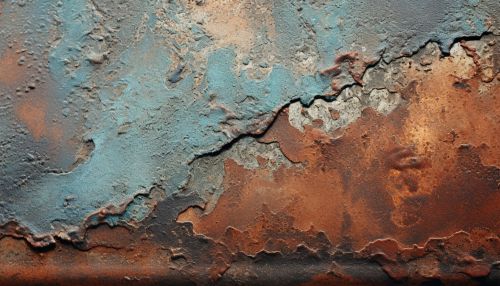Oxidative degradation
Introduction
Oxidative degradation is a natural process that occurs when organic materials are exposed to oxygen in the environment. This process plays a crucial role in various fields, including polymer science, food science, and environmental science. It is a complex series of chemical reactions that lead to the breakdown of materials, often resulting in a loss of physical and mechanical properties.


Chemistry of Oxidative Degradation
The chemistry of oxidative degradation is a multi-step process that involves the formation of free radicals, propagation, and termination. The initial step is the reaction of oxygen with the material, leading to the formation of free radicals. These radicals are highly reactive and can cause chain reactions, leading to further degradation of the material.
Formation of Free Radicals
The process begins with the absorption of energy by the material, either from heat, light, or radiation. This energy breaks the chemical bonds in the material, creating free radicals. These radicals are unstable and seek to stabilize themselves by reacting with other molecules, often oxygen. The reaction of the free radical with oxygen forms a peroxy radical, which is also highly reactive.
Propagation
The propagation phase involves the reaction of the peroxy radical with the material, leading to the formation of hydroperoxides and new free radicals. This process continues in a chain reaction, with each new radical causing further degradation of the material.
Termination
The termination phase occurs when two free radicals react with each other, forming a stable molecule and ending the chain reaction. However, the termination phase does not always occur, and the chain reaction can continue, leading to further degradation of the material.
Factors Influencing Oxidative Degradation
Several factors influence the rate and extent of oxidative degradation. These include the presence of catalysts, the type of material, and environmental conditions such as temperature and humidity.
Catalysts
Certain substances, known as catalysts, can increase the rate of oxidative degradation. These substances work by lowering the energy barrier for the formation of free radicals, making it easier for the degradation process to start. Common catalysts for oxidative degradation include metals such as iron and copper.
Type of Material
The type of material also plays a significant role in oxidative degradation. Some materials, such as polymers, are more susceptible to oxidative degradation due to their chemical structure. Polymers with a high degree of unsaturation, such as natural rubber, are particularly prone to oxidative degradation.
Environmental Conditions
Environmental conditions such as temperature and humidity can also affect the rate of oxidative degradation. Higher temperatures increase the rate of degradation by providing more energy for the formation of free radicals. Similarly, high humidity levels can accelerate the degradation process by providing more oxygen for the reaction.
Prevention of Oxidative Degradation
There are several methods to prevent or slow down the process of oxidative degradation. These include the use of antioxidants, stabilizers, and proper storage conditions.
Antioxidants
Antioxidants are substances that can slow down or prevent oxidative degradation. They work by reacting with the free radicals formed during the degradation process, neutralizing them and preventing them from causing further damage. Common antioxidants used in materials include phenolic antioxidants, phosphite antioxidants, and thioester antioxidants.
Stabilizers
Stabilizers are substances that can be added to materials to improve their resistance to oxidative degradation. These substances work by reacting with the degradation products, preventing them from causing further damage. Some stabilizers also act as antioxidants, neutralizing free radicals and slowing down the degradation process.
Storage Conditions
Proper storage conditions can also help to prevent oxidative degradation. This includes storing materials in a cool, dry environment, away from direct sunlight. Additionally, materials should be stored in airtight containers to limit their exposure to oxygen.
Applications of Oxidative Degradation
Despite its destructive nature, oxidative degradation has several applications in various fields. These include the aging of wine, the breakdown of pollutants, and the degradation of polymers.
Wine Aging
In the wine industry, oxidative degradation plays a crucial role in the aging process. The interaction of oxygen with the wine leads to the formation of new flavors and aromas, improving the wine's quality. However, excessive oxidation can lead to spoilage, so the process must be carefully controlled.
Pollutant Breakdown
Oxidative degradation is also used in environmental science for the breakdown of pollutants. Certain pollutants, such as volatile organic compounds (VOCs), can be broken down by oxidative degradation, reducing their impact on the environment.
Polymer Degradation
In the field of polymer science, oxidative degradation is a significant concern as it can lead to a loss of material properties. However, this process is also used in the design of biodegradable polymers. These polymers are designed to degrade through oxidation, allowing them to break down in the environment.
